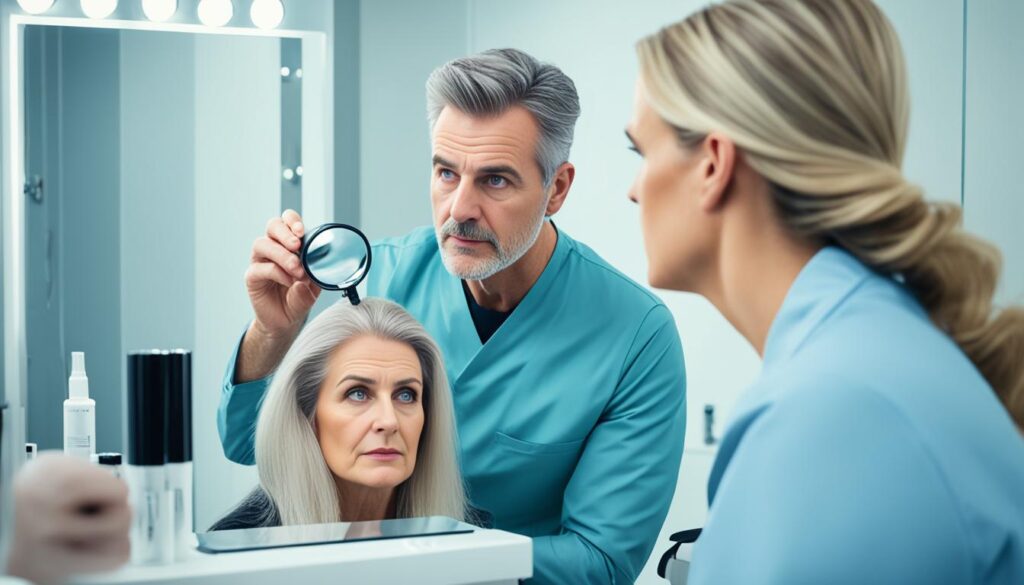Are you tired of dealing with hair loss problems such as hair thinning, balding, and scalp issues? Do you dream of finding effective solutions to promote hair growth and regrowth? Look no further! In this article, we will dive into the expert tips and remedies that can help you tackle hair loss head-on.
Say goodbye to male pattern baldness or female hair loss woes, as we uncover the causes of hair loss, treatment options, prevention strategies, and even natural remedies that you can try at home. Get ready to restore your confidence and achieve a full head of healthy hair!
Key Takeaways:
- Identify the type of hair loss you’re experiencing
- Understand the genetic factors contributing to hair loss
- Discover the impact of diet and nutrition on hair health
- Explore professional hair loss treatments and medications
- Learn about innovative hair regrowth solutions with technology
The Science Behind Hair Loss Problems
Hair loss is a complex issue that can have various underlying causes. Understanding the science behind hair loss is crucial to finding effective solutions. By delving into this scientific knowledge, we can gain insights into the different types of hair loss, genetic factors that contribute to it, and the role of diet and nutrition in maintaining healthy hair.
Identifying the Type of Hair Loss
To address hair loss effectively, it is essential to identify the specific type of hair loss you are experiencing. There are different types, including male pattern baldness, female hair loss, and alopecia areata. Each type has distinct characteristics and underlying causes.
Table:
| Type of Hair Loss | Characteristics | Underlying Causes |
|---|---|---|
| Male Pattern Baldness | Gradual hair thinning, receding hairline, bald spots | Genetic factors, hormonal changes |
| Female Hair Loss | Diffuse thinning, widening of the hair parting | Hormonal imbalances, genetic factors, stress |
| Alopecia Areata | Patchy hair loss, round or oval bald patches | Autoimmune disorder, genetic predisposition |
Understanding Genetic Factors
Genetic factors play a significant role in hair loss. Research has identified several genes that contribute to the susceptibility of hair follicles to miniaturization, a process that leads to hair thinning and eventual hair loss. Genetic testing can provide valuable insights into an individual’s predisposition to hair loss, allowing for targeted treatment approaches.
Recognizing the Role of Diet and Nutrition
Diet and nutrition also play a crucial role in the health of our hair. A lack of essential nutrients, such as vitamins, minerals, and proteins, can weaken hair follicles and lead to excessive hair shedding. Conversely, a well-balanced diet that includes nutrients like biotin, iron, and omega-3 fatty acids can promote strong, vibrant hair.

By understanding the science behind hair loss, identifying the type of hair loss, and recognizing the role of genetic factors and diet and nutrition, you can make informed decisions about the most suitable treatments and lifestyle changes. In the following sections, we will explore expert tips and solutions to help you combat hair loss and promote healthy hair growth.
Step-by-Step Diagnosis of Hair Thinning Issues
Diagnosing the cause of hair thinning is a crucial step in finding an effective solution. To accurately identify the root cause of your hair thinning problem, dermatologists or hair loss specialists may perform a series of tests and examinations.
By following this step-by-step diagnostic process, you can gain a better understanding of the underlying factors contributing to your hair thinning and tailor your treatment accordingly.
- Medical History: Your doctor will review your medical history, including any family history of hair loss, recent illnesses, or medications that may be contributing to the issue.
- Scalp Examination: A thorough examination of your scalp will be performed to assess the condition of your hair follicles, scalp health, and any signs of inflammation or infection.
- Trichoscopy: Trichoscopy involves using a specialized magnifying device to examine your hair and scalp in detail. It helps identify hair shaft abnormalities, patterns of hair loss, and signs of scalp disorders.
- Blood Tests: Blood tests may be conducted to check for underlying health conditions or hormonal imbalances that could be contributing to your hair thinning.
- Pull Test: The pull test involves gently tugging on a small amount of hair to see how many strands come out. This helps determine the stage and severity of hair loss.
- Biopsy: In some cases, a scalp biopsy may be recommended to evaluate the hair follicles and surrounding tissues under a microscope. This helps identify any structural abnormalities or underlying conditions.

By following this step-by-step diagnosis process, you can collaborate with your healthcare provider to accurately pinpoint the cause of your hair thinning. This comprehensive evaluation will guide the development of a personalized treatment plan to address your specific needs.
Professional Hair Loss Treatments and Medications
When it comes to treating hair loss, there are several professional options available that can help you regain a full and healthy head of hair. From FDA-approved medications to surgical hair restoration procedures, these treatments offer effective solutions to combat hair loss and promote hair growth.
Exploring FDA-Approved Medications
One of the most common professional hair loss treatments is the use of FDA-approved medications. These medications have been clinically tested and proven to effectively slow down hair loss and stimulate hair regrowth. One such medication is minoxidil, which is available in both topical and oral forms. Minoxidil works by increasing blood flow to the hair follicles, promoting hair growth.
Another FDA-approved medication is finasteride, which is available in a pill form. Finasteride works by blocking the hormone responsible for hair loss, preventing further hair thinning and promoting hair regrowth. It is important to note that both minoxidil and finasteride require consistent usage to see results, and they may take several months for noticeable improvements.
Effective Usage of Minoxidil and Finasteride
When using minoxidil, it is crucial to follow the instructions provided by your healthcare professional. Apply the solution or foam directly to the scalp, focusing on the areas of hair loss. It is recommended to use minoxidil twice a day, consistently, for optimal results. Patience is key, as it may take several months before significant hair growth is observed.
For the effective usage of finasteride, take the prescribed dosage as directed by your healthcare professional. It is important to note that finasteride is typically recommended for men only and may not be suitable for women. Always consult with your healthcare professional before starting any medication regimen to determine if it is suitable for you and to discuss any potential side effects.
Surgical Hair Restoration: Benefits and Risks
In cases where medication and other treatments have not provided satisfactory results, surgical hair restoration procedures can offer a more permanent solution. One common procedure is hair transplantation, where hair follicles from areas of healthy hair growth are extracted and transplanted to the areas with thinning or no hair.
Hair transplantation can provide natural-looking results, restoring a full head of hair. However, it is important to consider the benefits and risks associated with the procedure. Benefits include long-term results, improved self-confidence, and a permanent solution to hair loss. On the other hand, risks may include scarring, infections, and the possibility of the transplanted hair not growing as expected.
Before considering surgical hair restoration, it is crucial to consult with a qualified and experienced hair transplant surgeon who can evaluate your specific situation and provide personalized recommendations.

Innovative Hair Regrowth Solutions Through Technology
Technology has revolutionized the field of hair regrowth, offering innovative solutions for individuals struggling with hair loss. Two cutting-edge treatments that have gained significant attention are laser therapy and platelet-rich plasma (PRP) therapy.
Laser therapy for hair growth involves using low-level laser devices or laser combs to stimulate hair follicles, promoting new hair growth. This non-invasive procedure works by increasing blood flow to the scalp and delivering nutrients to the hair follicles, resulting in thicker and healthier hair.
Platelet-rich plasma (PRP) therapy is another technological advancement in hair regrowth. This procedure involves extracting the patient’s own blood, isolating the platelet-rich plasma, and injecting it back into the scalp. The growth factors present in the plasma help stimulate hair follicles and promote new hair growth.
“Laser therapy and platelet-rich plasma (PRP) therapy are revolutionizing the way we treat hair loss. These innovative solutions offer promising results and are changing the lives of individuals struggling with hair loss.”
By exploring these innovative hair regrowth solutions, you can discover new options for addressing your hair loss concerns. Consult with a qualified professional to determine if laser therapy or PRP therapy is the right choice for you.
| Treatment | Benefits | Considerations |
|---|---|---|
| Laser Therapy |
|
|
| Platelet-Rich Plasma (PRP) Therapy |
|
|
These innovative solutions offer hope to individuals seeking effective treatments for hair regrowth. However, it’s essential to consult with a healthcare professional to determine the most suitable approach based on your specific needs and circumstances.
Natural Remedies for Strengthening and Restoring Hair
Natural remedies can be a valuable addition to your hair care routine. Not only are they often more affordable and accessible than professional treatments, but they can also provide effective results for strengthening and restoring your hair.
Homemade Hair Growth Treatments
One of the best ways to promote hair growth is by using homemade hair growth treatments. These remedies can be made using easily accessible ingredients found in your kitchen. For example, a mixture of coconut oil, honey, and avocado can deeply nourish and moisturize your hair, promoting healthy growth.
Applying a mixture of onion juice and aloe vera gel to your scalp can also stimulate hair follicles and encourage regrowth. These homemade treatments are not only natural but can also be customized to target your specific hair concerns.
The Impact of Essential Oils
Essential oils have long been used for their beneficial properties in promoting hair growth and improving scalp health. Some essential oils, such as rosemary, peppermint, and lavender, can help increase blood circulation in the scalp and stimulate hair follicles.
These oils can be diluted with a carrier oil, such as coconut or jojoba oil, and applied to the scalp for a soothing and invigorating massage. Regular use of essential oils can lead to stronger, thicker, and healthier hair.
Dietary Adjustments for Healthier Hair
What you eat can have a significant impact on the health of your hair. Incorporating certain foods into your diet can provide the essential nutrients needed for strong and vibrant hair. Foods rich in protein, such as lean meats, eggs, and lentils, can help support hair growth.
Adding foods high in omega-3 fatty acids, like salmon and walnuts, can nourish the scalp and prevent dryness. Additionally, consuming plenty of fruits and vegetables, which are rich in vitamins and antioxidants, can contribute to overall hair health. By making these dietary adjustments, you can promote healthier hair from the inside out.

Lifestyle Changes to Prevent Hair Loss
Making certain lifestyle changes can have a significant impact on preventing hair loss and promoting healthy hair growth. By adopting a few simple habits, you can optimize the health of your hair and minimize the risk of future hair loss. Here are some lifestyle factors to consider and tips for maintaining a healthy lifestyle that supports hair growth:
1. Balanced Diet:
Ensure that you are consuming a well-rounded diet rich in essential nutrients needed for healthy hair, such as protein, vitamins (especially B vitamins), minerals (like iron, zinc, and selenium), and omega-3 fatty acids. Incorporate a variety of fruits, vegetables, lean meats, fish, whole grains, and healthy fats into your meals.
2. Regular Exercise:
Engaging in regular physical activity improves overall blood circulation, including to the scalp, which promotes hair growth. Aim for at least 30 minutes of moderate-intensity exercise most days of the week.
3. Stress Management:
Stress can contribute to hair loss, so it’s important to find effective stress management techniques. Try practicing relaxation techniques such as deep breathing, meditation, yoga, or engaging in activities you enjoy to reduce stress levels and promote overall well-being.
4. Good Sleep Habits:
Getting enough restful sleep is vital for healthy hair growth. Aim to establish a regular sleep routine, ensuring you get 7-9 hours of quality sleep each night.
Remember that preventing hair loss and maintaining healthy hair also requires avoiding damaging hair practices, such as excessive heat styling, tight hairstyles, and harsh chemical treatments. By making these lifestyle changes and adopting hair-friendly habits, you can take control of your hair health and enjoy strong, vibrant locks for years to come.

Creating an Effective Hair Care Routine
Establishing an effective hair care routine is crucial for maintaining healthy hair and preventing hair loss. By following a consistent and tailored routine, you can promote the strength, resilience, and overall health of your hair.
Choosing the Right Hair Care Products
When it comes to choosing hair care products, it’s important to consider your specific hair type and concerns. Look for products that are formulated to address your unique needs, such as shampoos and conditioners for dry or damaged hair, volumizing products for thin or limp hair, and products designed to combat frizz or control oiliness.
In addition, pay attention to the ingredients in the products you use. Avoid harsh chemicals, sulfates, and parabens, as they can strip your hair of its natural oils and cause damage over time. Instead, opt for products that are free of these harmful ingredients and contain nourishing and moisturizing elements, such as argan oil, coconut oil, or shea butter.
Tips for Gentle Hair Handling
Properly handling your hair is essential for preventing breakage and damage. Here are some tips to keep in mind:
- Use a wide-toothed comb or a brush with soft bristles to detangle your hair gently.
- Avoid brushing your hair when it’s wet, as wet hair is more fragile and prone to breakage. Instead, use a wide-toothed comb or your fingers to remove tangles.
- Avoid excessive heat styling, such as using flat irons or curling wands, as it can weaken your hair and lead to breakage. If you must use heat styling tools, apply a heat protectant spray beforehand.
- Avoid pulling your hair tightly into hairstyles that create tension, such as tight ponytails or braids. Instead, opt for looser styles or use hair-friendly accessories like scrunchies or spiral hair ties.
Mitigating Damage from Environmental Factors
Environmental factors can contribute to hair damage and breakage. Here are some tips to protect your hair from these external stressors:
- Wear a hat or scarf to shield your hair from the sun’s harmful UV rays.
- Rinse your hair with lukewarm or cool water instead of hot water, as hot water can strip away natural oils and cause dryness.
- Minimize your exposure to chlorine in swimming pools by wetting your hair with clean water before entering the pool and rinsing it afterward.
- Avoid overexposure to heat from styling tools, such as blow dryers or hot rollers.
- Consider using a leave-in conditioner or a hair serum with UV protection to shield your hair from environmental damage.
By incorporating these tips into your hair care routine, you can create an effective regimen that promotes the health and vitality of your hair. Remember, consistency and gentle care are key to achieving and maintaining healthy hair.

Conclusion
And there you have it, a comprehensive guide to tackling hair loss problems. We’ve covered everything from understanding the science behind hair loss to exploring professional treatments, natural remedies, and lifestyle changes that can promote healthier hair growth.
By following the expert tips and solutions presented in this article, you can take proactive steps towards addressing your hair loss concerns. Remember, it’s important to identify the type of hair loss you’re experiencing, whether it’s genetic, dietary, or caused by other factors. Armed with this knowledge, you can explore the right treatments and make the necessary lifestyle adjustments to improve the health of your hair.
From FDA-approved medications like minoxidil and finasteride to innovative hair regrowth solutions through technology such as laser therapy and platelet-rich plasma (PRP) therapy, there are plenty of options to choose from. Additionally, incorporating natural remedies into your hair care routine and making lifestyle changes to reduce stress and promote overall wellness can go a long way in preventing hair loss.
In conclusion, solving hair loss requires a comprehensive approach that takes into account the underlying causes, professional treatments, natural remedies, and positive lifestyle changes. By following the expert advice and solutions discussed in this article, you can take control of your hair loss problems and achieve healthier, fuller hair. So go ahead, embrace your journey towards a head of hair that’s as confident as you are!





